Medical Named Entity Recognition
Medical named entity recognition is the process of identifying and categorizing medical terms or entities in text data.
Papers and Code
KU AIGEN ICL EDI@BC8 Track 3: Advancing Phenotype Named Entity Recognition and Normalization for Dysmorphology Physical Examination Reports
Jan 16, 2025The objective of BioCreative8 Track 3 is to extract phenotypic key medical findings embedded within EHR texts and subsequently normalize these findings to their Human Phenotype Ontology (HPO) terms. However, the presence of diverse surface forms in phenotypic findings makes it challenging to accurately normalize them to the correct HPO terms. To address this challenge, we explored various models for named entity recognition and implemented data augmentation techniques such as synonym marginalization to enhance the normalization step. Our pipeline resulted in an exact extraction and normalization F1 score 2.6\% higher than the mean score of all submissions received in response to the challenge. Furthermore, in terms of the normalization F1 score, our approach surpassed the average performance by 1.9\%. These findings contribute to the advancement of automated medical data extraction and normalization techniques, showcasing potential pathways for future research and application in the biomedical domain.
Accurate Medical Named Entity Recognition Through Specialized NLP Models
Dec 11, 2024This study evaluated the effect of BioBERT in medical text processing for the task of medical named entity recognition. Through comparative experiments with models such as BERT, ClinicalBERT, SciBERT, and BlueBERT, the results showed that BioBERT achieved the best performance in both precision and F1 score, verifying its applicability and superiority in the medical field. BioBERT enhances its ability to understand professional terms and complex medical texts through pre-training on biomedical data, providing a powerful tool for medical information extraction and clinical decision support. The study also explored the privacy and compliance challenges of BioBERT when processing medical data, and proposed future research directions for combining other medical-specific models to improve generalization and robustness. With the development of deep learning technology, the potential of BioBERT in application fields such as intelligent medicine, personalized treatment, and disease prediction will be further expanded. Future research can focus on the real-time and interpretability of the model to promote its widespread application in the medical field.
On Fusing ChatGPT and Ensemble Learning in Discon-tinuous Named Entity Recognition in Health Corpora
Dec 22, 2024Named Entity Recognition has traditionally been a key task in natural language processing, aiming to identify and extract important terms from unstructured text data. However, a notable challenge for contemporary deep-learning NER models has been identifying discontinuous entities, which are often fragmented within the text. To date, methods to address Discontinuous Named Entity Recognition have not been explored using ensemble learning to the best of our knowledge. Furthermore, the rise of large language models, such as ChatGPT in recent years, has shown significant effectiveness across many NLP tasks. Most existing approaches, however, have primarily utilized ChatGPT as a problem-solving tool rather than exploring its potential as an integrative element within ensemble learning algorithms. In this study, we investigated the integration of ChatGPT as an arbitrator within an ensemble method, aiming to enhance performance on DNER tasks. Our method combines five state-of-the-art NER models with ChatGPT using custom prompt engineering to assess the robustness and generalization capabilities of the ensemble algorithm. We conducted experiments on three benchmark medical datasets, comparing our method against the five SOTA models, individual applications of GPT-3.5 and GPT-4, and a voting ensemble method. The results indicate that our proposed fusion of ChatGPT with the ensemble learning algorithm outperforms the SOTA results in the CADEC, ShARe13, and ShARe14 datasets, showcasing its potential to enhance NLP applications in the healthcare domain.
An Experimental Study on Data Augmentation Techniques for Named Entity Recognition on Low-Resource Domains
Nov 21, 2024Named Entity Recognition (NER) is a machine learning task that traditionally relies on supervised learning and annotated data. Acquiring such data is often a challenge, particularly in specialized fields like medical, legal, and financial sectors. Those are commonly referred to as low-resource domains, which comprise long-tail entities, due to the scarcity of available data. To address this, data augmentation techniques are increasingly being employed to generate additional training instances from the original dataset. In this study, we evaluate the effectiveness of two prominent text augmentation techniques, Mention Replacement and Contextual Word Replacement, on two widely-used NER models, Bi-LSTM+CRF and BERT. We conduct experiments on four datasets from low-resource domains, and we explore the impact of various combinations of training subset sizes and number of augmented examples. We not only confirm that data augmentation is particularly beneficial for smaller datasets, but we also demonstrate that there is no universally optimal number of augmented examples, i.e., NER practitioners must experiment with different quantities in order to fine-tune their projects.
Zero- and Few-shot Named Entity Recognition and Text Expansion in Medication Prescriptions using ChatGPT
Sep 26, 2024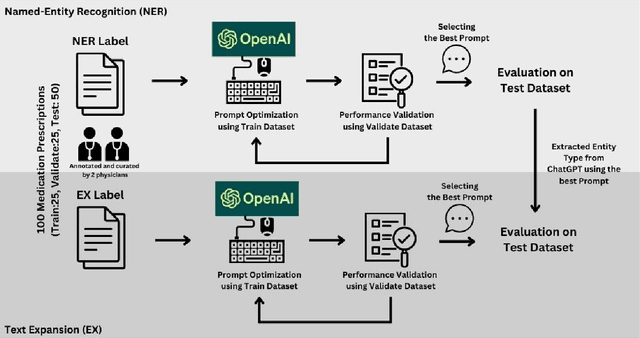

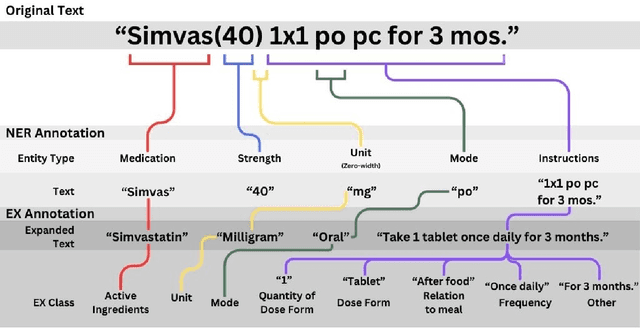
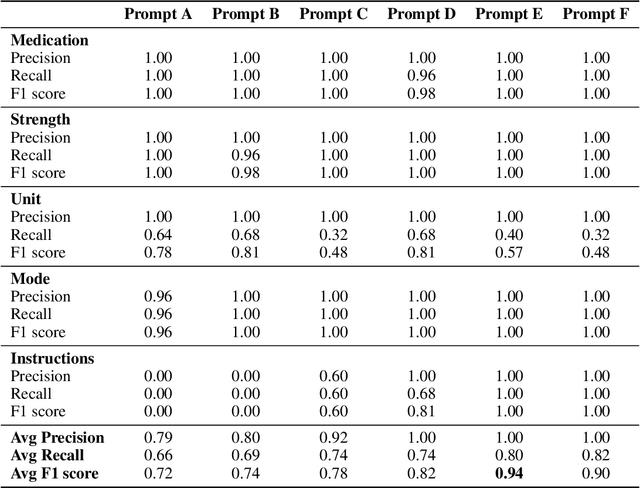
Introduction: Medication prescriptions are often in free text and include a mix of two languages, local brand names, and a wide range of idiosyncratic formats and abbreviations. Large language models (LLMs) have shown promising ability to generate text in response to input prompts. We use ChatGPT 3.5 to automatically structure and expand medication statements in discharge summaries and thus make them easier to interpret for people and machines. Methods: Named-entity Recognition (NER) and Text Expansion (EX) are used in a zero- and few-shot setting with different prompt strategies. 100 medication statements were manually annotated and curated. NER performance was measured by using strict and partial matching. For the task EX, two experts interpreted the results by assessing semantic equivalence between original and expanded statements. The model performance was measured by precision, recall, and F1 score. Results: For NER, the best-performing prompt reached an average F1 score of 0.94 in the test set. For EX, the few-shot prompt showed superior performance among other prompts, with an average F1 score of 0.87. Conclusion: Our study demonstrates good performance for NER and EX tasks in free-text medication statements using ChatGPT. Compared to a zero-shot baseline, a few-shot approach prevented the system from hallucinating, which would be unacceptable when processing safety-relevant medication data.
HealthQ: Unveiling Questioning Capabilities of LLM Chains in Healthcare Conversations
Sep 28, 2024



In digital healthcare, large language models (LLMs) have primarily been utilized to enhance question-answering capabilities and improve patient interactions. However, effective patient care necessitates LLM chains that can actively gather information by posing relevant questions. This paper presents HealthQ, a novel framework designed to evaluate the questioning capabilities of LLM healthcare chains. We implemented several LLM chains, including Retrieval-Augmented Generation (RAG), Chain of Thought (CoT), and reflective chains, and introduced an LLM judge to assess the relevance and informativeness of the generated questions. To validate HealthQ, we employed traditional Natural Language Processing (NLP) metrics such as Recall-Oriented Understudy for Gisting Evaluation (ROUGE) and Named Entity Recognition (NER)-based set comparison, and constructed two custom datasets from public medical note datasets, ChatDoctor and MTS-Dialog. Our contributions are threefold: we provide the first comprehensive study on the questioning capabilities of LLMs in healthcare conversations, develop a novel dataset generation pipeline, and propose a detailed evaluation methodology.
Named Clinical Entity Recognition Benchmark
Oct 07, 2024
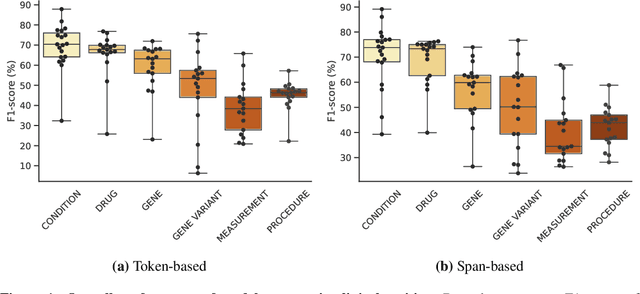
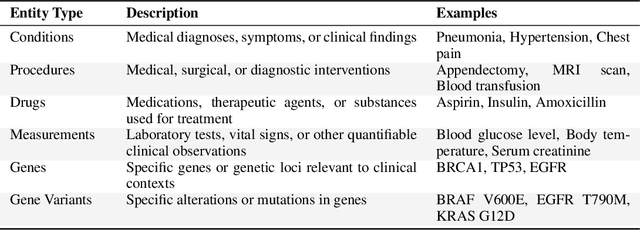
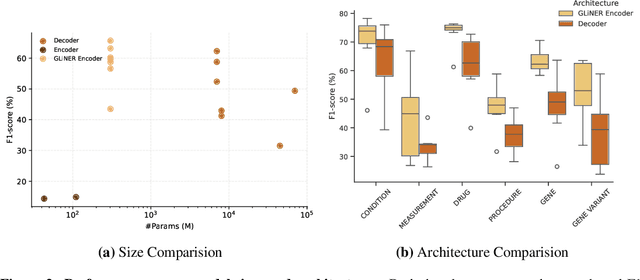
This technical report introduces a Named Clinical Entity Recognition Benchmark for evaluating language models in healthcare, addressing the crucial natural language processing (NLP) task of extracting structured information from clinical narratives to support applications like automated coding, clinical trial cohort identification, and clinical decision support. The leaderboard provides a standardized platform for assessing diverse language models, including encoder and decoder architectures, on their ability to identify and classify clinical entities across multiple medical domains. A curated collection of openly available clinical datasets is utilized, encompassing entities such as diseases, symptoms, medications, procedures, and laboratory measurements. Importantly, these entities are standardized according to the Observational Medical Outcomes Partnership (OMOP) Common Data Model, ensuring consistency and interoperability across different healthcare systems and datasets, and a comprehensive evaluation of model performance. Performance of models is primarily assessed using the F1-score, and it is complemented by various assessment modes to provide comprehensive insights into model performance. The report also includes a brief analysis of models evaluated to date, highlighting observed trends and limitations. By establishing this benchmarking framework, the leaderboard aims to promote transparency, facilitate comparative analyses, and drive innovation in clinical entity recognition tasks, addressing the need for robust evaluation methods in healthcare NLP.
Disease Entity Recognition and Normalization is Improved with Large Language Model Derived Synthetic Normalized Mentions
Oct 10, 2024



Background: Machine learning methods for clinical named entity recognition and entity normalization systems can utilize both labeled corpora and Knowledge Graphs (KGs) for learning. However, infrequently occurring concepts may have few mentions in training corpora and lack detailed descriptions or synonyms, even in large KGs. For Disease Entity Recognition (DER) and Disease Entity Normalization (DEN), this can result in fewer high quality training examples relative to the number of known diseases. Large Language Model (LLM) generation of synthetic training examples could improve performance in these information extraction tasks. Methods: We fine-tuned a LLaMa-2 13B Chat LLM to generate a synthetic corpus containing normalized mentions of concepts from the Unified Medical Language System (UMLS) Disease Semantic Group. We measured overall and Out of Distribution (OOD) performance for DER and DEN, with and without synthetic data augmentation. We evaluated performance on 3 different disease corpora using 4 different data augmentation strategies, assessed using BioBERT for DER and SapBERT and KrissBERT for DEN. Results: Our synthetic data yielded a substantial improvement for DEN, in all 3 training corpora the top 1 accuracy of both SapBERT and KrissBERT improved by 3-9 points in overall performance and by 20-55 points in OOD data. A small improvement (1-2 points) was also seen for DER in overall performance, but only one dataset showed OOD improvement. Conclusion: LLM generation of normalized disease mentions can improve DEN relative to normalization approaches that do not utilize LLMs to augment data with synthetic mentions. Ablation studies indicate that performance gains for DEN were only partially attributable to improvements in OOD performance. The same approach has only a limited ability to improve DER. We make our software and dataset publicly available.
Towards Evaluating and Building Versatile Large Language Models for Medicine
Aug 22, 2024In this study, we present MedS-Bench, a comprehensive benchmark designed to evaluate the performance of large language models (LLMs) in clinical contexts. Unlike existing benchmarks that focus on multiple-choice question answering, MedS-Bench spans 11 high-level clinical tasks, including clinical report summarization, treatment recommendations, diagnosis, named entity recognition, and medical concept explanation, among others. We evaluated six leading LLMs, e.g., MEDITRON, Mistral, InternLM 2, Llama 3, GPT-4, and Claude-3.5 using few-shot prompting, and found that even the most sophisticated models struggle with these complex tasks. To address these limitations, we developed MedS-Ins, a large-scale instruction tuning dataset for medicine. MedS-Ins comprises 58 medically oriented language corpora, totaling 13.5 million samples across 122 tasks. To demonstrate the dataset's utility, we conducted a proof-of-concept experiment by performing instruction tuning on a lightweight, open-source medical language model. The resulting model, MMedIns-Llama 3, significantly outperformed existing models across nearly all clinical tasks. To promote further advancements in the application of LLMs to clinical challenges, we have made the MedS-Ins dataset fully accessible and invite the research community to contribute to its expansion.Additionally, we have launched a dynamic leaderboard for MedS-Bench, which we plan to regularly update the test set to track progress and enhance the adaptation of general LLMs to the medical domain. Leaderboard: https://henrychur.github.io/MedS-Bench/. Github: https://github.com/MAGIC-AI4Med/MedS-Ins.
LLMs are not Zero-Shot Reasoners for Biomedical Information Extraction
Aug 22, 2024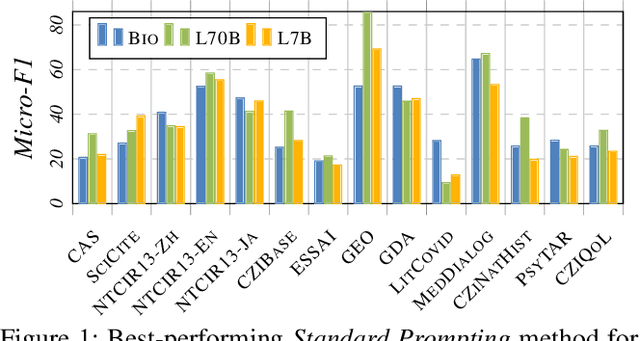
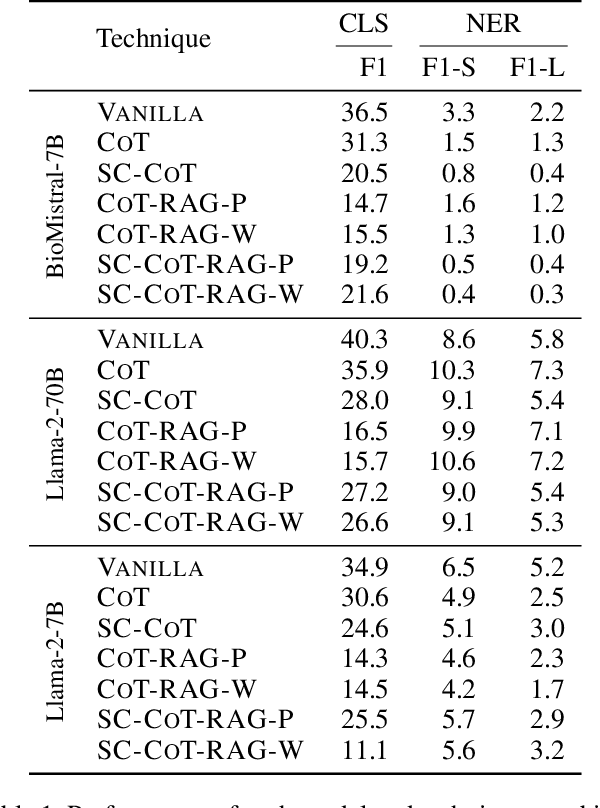
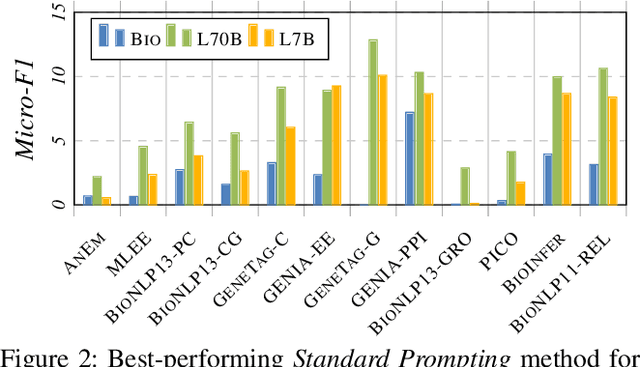
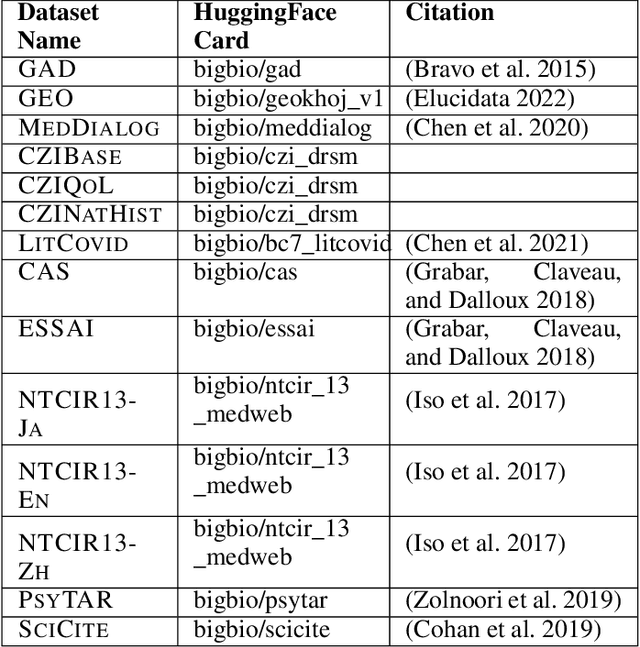
Large Language Models (LLMs) are increasingly adopted for applications in healthcare, reaching the performance of domain experts on tasks such as question answering and document summarisation. Despite their success on these tasks, it is unclear how well LLMs perform on tasks that are traditionally pursued in the biomedical domain, such as structured information extration. To breach this gap, in this paper, we systematically benchmark LLM performance in Medical Classification and Named Entity Recognition (NER) tasks. We aim to disentangle the contribution of different factors to the performance, particularly the impact of LLMs' task knowledge and reasoning capabilities, their (parametric) domain knowledge, and addition of external knowledge. To this end we evaluate various open LLMs -- including BioMistral and Llama-2 models -- on a diverse set of biomedical datasets, using standard prompting, Chain-of-Thought (CoT) and Self-Consistency based reasoning as well as Retrieval-Augmented Generation (RAG) with PubMed and Wikipedia corpora. Counter-intuitively, our results reveal that standard prompting consistently outperforms more complex techniques across both tasks, laying bare the limitations in the current application of CoT, self-consistency and RAG in the biomedical domain. Our findings suggest that advanced prompting methods developed for knowledge- or reasoning-intensive tasks, such as CoT or RAG, are not easily portable to biomedical tasks where precise structured outputs are required. This highlights the need for more effective integration of external knowledge and reasoning mechanisms in LLMs to enhance their performance in real-world biomedical applications.
 Add to Chrome
Add to Chrome Add to Firefox
Add to Firefox Add to Edge
Add to Edge